I'm making a Test Editor from a base that I got from a YouTube tutorial. I was trying to make highlighted the python's statements, but when I write a statement, it colorizes all the lines, and I thought that the problem is the use of indexes I make.
This is the code:
import tkinter as tk
from tkinter import filedialog
from tkinter import messagebox
class Menubar:
def __init__(self, parent):
font_specs = 14
menubar = tk.Menu(parent.master)
parent.master.config(menu = menubar)
file_dropdown = tk.Menu(menubar, font = font_specs, tearoff = 0)
file_dropdown.add_command(label = "Nuovo file",
accelerator = "Ctrl + N",
command = parent.new_file)
file_dropdown.add_command(label = "Apri file",
accelerator = "Ctrl + O",
command = parent.open_file)
file_dropdown.add_command(label = "Salva",
accelerator = "Ctrl + S",
command = parent.save)
file_dropdown.add_command(label = "Salva con nome",
accelerator = "Ctrl + Shit + S",
command = parent.save_as)
file_dropdown.add_separator()
file_dropdown.add_command(label = "Esci",
command = parent.master.destroy)
about_dropdown = tk.Menu(menubar, font = font_specs, tearoff = 0)
about_dropdown.add_command(label = "Note di rilascio",
command = self.show_about_message)
about_dropdown.add_separator()
about_dropdown.add_command(label = "About",
command = self.show_release_notes)
settings_dropdown = tk.Menu(menubar, font = font_specs, tearoff = 0)
settings_dropdown.add_command(label = "Cambia lo sfondo dell'editor",
command = parent.change_background)
menubar.add_cascade(label = "File", menu = file_dropdown)
menubar.add_cascade(label = "About", menu = about_dropdown)
menubar.add_cascade(label = "Settings", menu = settings_dropdown)
def show_about_message(self):
box_title = "Riguardo PyText"
box_message = "Il mio primo editor testuale creato con Python e TkInter!"
messagebox.showinfo(box_title, box_message)
def show_release_notes(self):
box_title = "Note di Rilascio"
box_message = "Versione 0.1 (Beta) Santa"
messagebox.showinfo(box_title, box_message)
class Statusbar:
def __init__(self, parent):
font_specs = 12
self.status = tk.StringVar()
self.status.set("PyText - 0.1 Santa")
label = tk.Label(parent.text_area, textvariable = self.status,
fg = "black", bg = "lightgrey", anchor = "sw")
label.pack(side = tk.BOTTOM, fill = tk.BOTH)
def update_status(self, *args):
if isinstance(args[0], bool):
self.status.set("Il tuo file è stato salvato!")
else:
self.status.set("PyText - 0.1 Santa")
class PyText:
"""
Classe-Madre dell'applicazione
"""
def __init__(self, master):
master.title("Untitled - PyText")
master.geometry("1200x700")
font_specs = 18
self.master = master
self.filename = None
self.text_area = tk.Text(master, font = font_specs, insertbackground = "black")
self.scroll = tk.Scrollbar(master, command = self.text_area.yview)
self.text_area.configure(yscrollcommand = self.scroll.set)
self.text_area.pack(side = tk.LEFT, fill = tk.BOTH, expand = True)
self.scroll.pack(side = tk.RIGHT, fill = tk.Y)
self.menubar = Menubar(self)
self.statusbar = Statusbar(self)
self.bind_shortcuts()
def set_window_title(self, name = None):
if name:
self.master.title(name + " - PyText")
else:
self.master.title("Untitled - PyText")
def new_file(self, *args):
self.text_area.delete(1.0, tk.END)
self.filename = None
self.set_window_title()
def open_file(self, *args):
self.filename = filedialog.askopenfilename(
defaultextension = ".txt",
filetypes = [("Tutti i file", "*.*"),
("File di Testo", "*.txt"),
("Script Python", "*.py"),
("Markdown Text", "*.md"),
("File JavaScript", "*.js"),
("Documenti Html", "*.html"),
("Documenti CSS", "*.css"),
("Programmi Java", "*.java")]
)
if self.filename:
self.text_area.delete(1.0, tk.END)
with open(self.filename, "r") as f:
self.text_area.insert(1.0, f.read())
self.set_window_title(self.filename)
def save(self, *args):
if self.filename:
try:
textarea_content = self.text_area.get(1.0, tk.END)
with open(self.filename, "w") as f:
f.write(textarea_content)
self.statusbar.update_status(True)
except Exception as e:
print(e)
else:
self.save_as()
def save_as(self, *args):
try:
new_file = filedialog.asksaveasfilename(
initialfile = "Untitled.txt",
defaultextension = ".txt",
filetypes = [("Tutti i file", "*.*"),
("File di Testo", "*.txt"),
("Script Python", "*.py"),
("Markdown Text", "*.md"),
("File JavaScript", "*.js"),
("Documenti Html", "*.html"),
("Documenti CSS", "*.css"),
("Programmi Java", "*.java")]
)
textarea_content = self.text_area.get(1.0, tk.END)
with open(new_file, "w") as f:
f.write(textarea_content)
self.filename = new_file
self.set_window_title(self.filename)
self.statusbar.update_status(True)
except Exception as e:
print(e)
def change_background(self):
self.text_area.config(background = "black", foreground = "white",
insertbackground = "white", insertwidth = 2)
def highlight_text(self, *args):
tags = {
"import": "pink",
"from": "pink",
"def": "blue",
"for": "purple",
"while": "purple"
}
textarea_content = self.text_area.get(1.0, tk.END)
lines = textarea_content.split("\n")
for row in lines:
for tag in tags:
index = row.find(tag) + 1.0
if index > 0.0:
self.text_area.tag_add(tag, index, index + len(tag) -1)
self.text_area.tag_config(tag, foreground = tags.get(tag))
print("Nuovo tag aggiunto:", tag)
print("Funzione eseguita:", args, "\n")
def bind_shortcuts(self):
self.text_area.bind("<Control-n>", self.new_file)
self.text_area.bind("<Control-o>", self.open_file)
self.text_area.bind("<Control-s>", self.save)
self.text_area.bind("<Control-S>", self.save_as)
self.text_area.bind("<Key>", self.highlight_text, self.statusbar.update_status)
if __name__ == "__main__":
master = tk.Tk()
pt = PyText(master)
master.mainloop()
How can I get the index of the line where is the statement?
